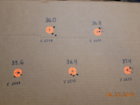Lefty - perhaps you should read through the first few pages of Erik Cortina's Load Development at 100 Yds thread:
http://forum.accurateshooter.com/threads/long-range-load-development-at-100-yards.3814361/. He explains very clearly and concisely how to conduct such an OCW test, and how to interpret the results. There are now over 100 pages in that thread if you want plenty of examples where Erik has analyzed posted groups and explained exactly why he picked a given charge weight region to test further.
The whole point of the OCW approach is to find at least two
successive charge weight increments where the group center point does not move in relation to the point of aim. It has nothing at all to do with group size or vertical spread. By those criteria, consider re-testing the Creedmoor in 0.1 to 0.2 gr increments from 36.8 to 37.4 gr. For the .308, it's a little more difficult to decipher. It could be argued that 39.0 to 39.4 have about the same group center, but the same could possibly be said for 40.6 to 41.0 gr. Once you settle on a charge weight where the group center point doesn't change much for at least 0.1 to 0.2 gr to either side of the chosen charge weight, then you tune in group spread (size) via a seating depth test.














